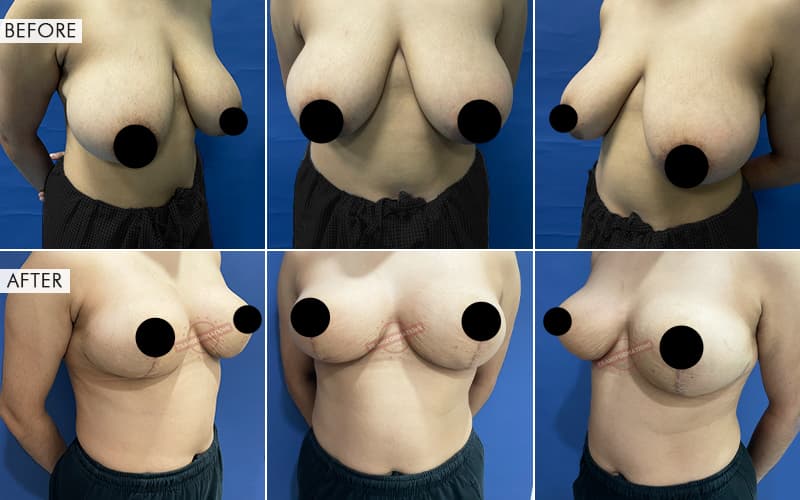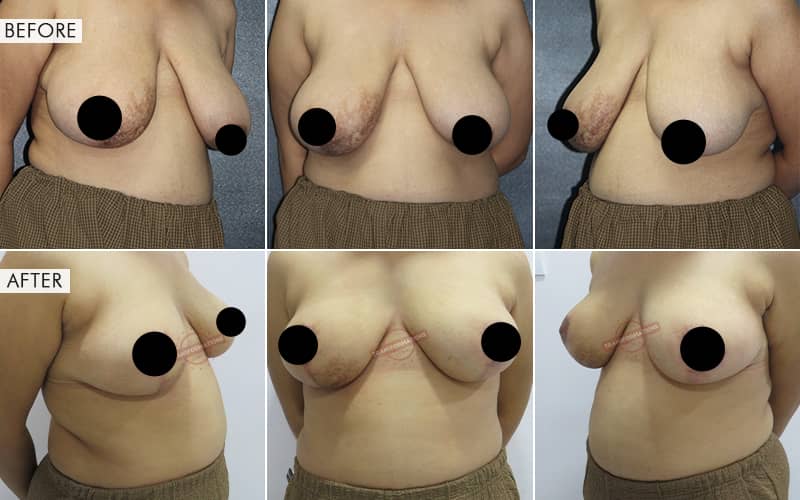Breas-t Reduction Surgery in Mumbai, India
Breas-t reduction surgery involves the removal of breas-t tissue, skin, and fat to reduce breas-t size or reshape the breas-ts. Breas-t reduction surgery, medically termed "reduction mammoplasty", for women with enlarged breas-ts is performed for numerous concerns like excessive breas-t weight that may be further causing back, shoulder, and neck pain. If bra straps cause grooves in the shoulders, resulting in pain, depression, irritability, redness, or pigmentation in the shoulder region. Genetic predisposition, hormone sensitivity, weight gain, and some medications can contribute to breas-t enlargement.
Indications for Breas-t Reduction Surgery
For women dealing with the following symptoms, a breas-t reduction procedure can bring a lot of relief.
- Large breas-t that is not in proportion with the rest of the body.
- Even with minimal physical activity, an individual may experience daily shoulder, back, or neck pain.
- Struggling with falling or staying asleep.
- Breathing problems when lying on your back.
- Issues with bra straps digging into the shoulders (creating deep groves and depressions).
- The development of rashes or other irritations along the skin under the breas-ts.
- A tingling sensation around the breas-ts.
- Posture issues.
- Restrictions on physical activity.
Factors affecting the surgical technique for breas-t reduction in Mumbai
The following are some of the criteria that determine the breas-t reduction surgery technique:
- The breas-t's dimensions.
- The extent of sag or droop (ptosis).
- Boobs form.
- Symmetry.
- The nipple-areolar region's size and protrusion.
- The breas-t skin's elasticity.
- Body type and proportion.
- Personal preferences, aspirations, and objectives.
The patient's physiological and anatomical condition and desire to have the treatment must meet realistic expectations when choosing the breas-t reduction technique. The final formulation of the incision pattern for the particular procedure is based on the anticipated final balance between the elastic characteristics and the breas-t "foundation," which consists of the breas-t gland and soft tissue.
Pre-op Instructions for a Breas-t Reduction Procedure
Patients are asked to follow these "do's" to prepare for breas-t reduction surgery in Mumbai (India):
- Get a medical evaluation or lab tests at the best clinic for breas-t reduction in India.
- To help detect any potential future changes in breas-t tissue, get a baseline mammogram before the procedure and another one after it.
- Avoid smoking for at least two weeks before the surgery.
- One may need to stop taking certain medication if the surgeon suggests so. Anti-inflammatory drugs, and herbal supplements shouldn't be consumed because they increase bleeding.
Most Popular Techniques for Breas-t Reduction
How is a breas-t reduction procedure conducted?
Superficial incisions are made to remove the glandular tissue, extra skin, and fat during mammoplasty. Liposuction is used in some cases to get rid of extra fat. If excess skin is not a contributing factor and excess fat is the only cause of the enlarged breas-t, liposuction alone may be sufficient to achieve the desired results. However, when both excess skin and fat are the primary causes of enlarged and heavy breas-ts, excision is also necessary along with liposuction.
Step 1: Anaesthesia
Anesthesia is administered to mammoplasty patients as the first step for the procedure to be completed successfully.
Step 2: The Incision
There are several different kinds of incisions:
- A pattern of circles surrounds the areola.
- A keyhole or racquet-shaped pattern with an incision down to the boobs crease and around the areola
- An anchor-shaped or inverted T-shaped incision pattern
Step 3: Tissue removal and repositioning
The nipple is repositioned by following the incision. If necessary, the areola is decreased by removing skin from the edge. The tissue beneath the breas-t is raised, sculpted, and excess is eliminated.
Step 4: Closing the incision sites with sutures
To form and support the newly shaped breas-ts, layers of sutures are laid deep within the breas-t tissue. Surgical tape, skin adhesives, or both are then used to seal the skin. The sutures are placed so there won't be any visible scars, which makes it more acceptable to get the best outcomes possible with the fewest scars possible.
Results of a Breas-t Reduction Surgery
The effects of a mammoplasty may not require much waiting time because they are immediate. Over time, the swelling, bruising, discomfort, and scarring associated with the healing process will subside, and the incision line will disappear.
Things to know before a Breas-t Reduction Surgery
There are a few aspects of breas-t reduction surgery that a woman should be aware of:
- Depending on breas-t size and composition, breas-t size can be reduced. Most breas-t reduction candidates reduce their cup size by one to two.
- The candidate will most likely get a breas-t lift too. In case of excessive sagging, a breas-t reduction surgeon will remove excess tissue and skin to make the beas-ts smaller and then move the nipples up into position to give them a lift.
- The candidates will have scars although very less noticeable. Over several weeks, the swelling will gradually decrease. The scars usually fade a year following surgery.
- There is a possibility that the candidate will experience diminished nipple sensitivity. The nipples could feel numb right after surgery. The nipples nearly always regain some sensation, but it may take a month or two.
- Candidates may have drains in the breas-ts(for few days). This can decrease the swelling and discomfort while the candidate heals.
- The candidate will feel the most discomfort in the first few days after surgery. It is typical to have discomfort and soreness for several days. The candidate should not be reluctant to take painkillers at this time. Ask the surgeon about using creams or lotions, and resist the urge to scratch.
- For a while, it could be challenging to fall asleep. Discomfort and swelling can be lessened by keeping the upper body elevated. Additionally, the candidate must spend much of the healing time lying on their back. To avoid rolling, place pillows along the sides and beneath the knees.
- The candidate should refrain from strenuous activity and exercise for three to four weeks. Vigorous exercise is the last thing on the candidate's mind because the body will require energy to cure itself. However, the breas-t reduction surgeon in India advises the patient to walk immediately following the procedure. This aids in preventing blood clots.
- As the candidate heals, the breas-ts will continue to fluctuate in size and shape. It will take time for the breas-ts to adjust to their new look. The scars will also keep evolving. Most women are happy with the outcome of breas-t reduction surgery in Mumbai (India) because it also improves their quality of life.
Advantages of a Breas-t Reduction Surgery
- Heavy breas-ts frequently cause strain and discomfort in the back, neck, and shoulders. When a woman decides to get her breas-ts smaller, she can release all that stress, get rid of the agony, and enhance her quality of life.
- The plastic surgeon might advise breas-t reduction surgery if an individual's large breas-ts are out of proportion to their frame. By reducing their size, they will benefit from a more well-balanced body with breas-ts that look younger.
- Finding clothing that fits well if one has enlarged breas-ts can be challenging and stressful. Women can dress better if their breas-ts are proportionate to their bodies. Bra straps digging into the shoulders will also be relieved, preventing pain, marks, and scarring.
- Maintaining a healthy lifestyle may be challenging for women with large breas-ts. Exercise will be more enjoyable after breas-t reduction surgery, which is one of its most significant advantages. Reducing breas-t size may encourage activity if back, shoulder, or breas-t pain prevents someone from doing so.
- A person with large breas-ts may be more prone to rashes or infections in the lower breas-t and breas-t fold. Breas-t reduction surgery in India performed at Designer Bodyz can relieve these rashes or infections, improving hygiene and health.
Why Choose Designer Bodyz & Dr. Parag Telang?
- When choosing the best surgeon for breas-t reduction in India, it is important to check his qualifications. Dr. Parag Telang specializes in aesthetic as well as reconstructive plastic surgery and has several years of experience.
- He is a reputed cosmetic surgeon in India practicing at Designer Bodyz, and he makes sure to follow the highest standards for safety as well as hygiene.
- It is really important that a skilled surgeon like Dr. Parag Telang performs such surgeries so that there are no unwanted complications. He understands the needs and expectations of the patient as well as the anatomy of the face and plans the treatment accordingly.

Before and After

*Opinion / Results may vary person to person.

*Opinion / Results may vary person to person.

*Opinion / Results may vary person to person.
Clinic Timings (IST)
Monday to Saturday : 8:30 AM to 9:00 PM | Sunday Closed.
© Copyright 2022 - 2025, Designer Bodyz | All Rights Reserved. Powered by DigiLantern



